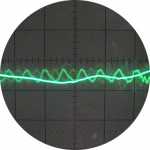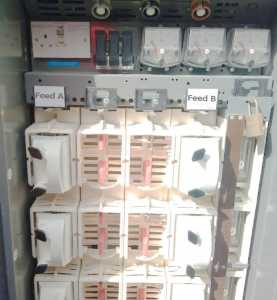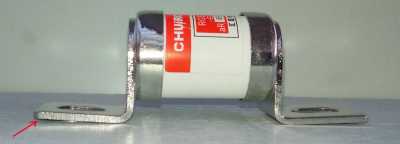Posted by: @chickenbigWill your battery storage need something similar for the connect-and-notify, or is G98 not required for storage only appliances?
The fact that it's storage isn't the salient point.
G98, G99 and G100 are rules relating to devices which export to the grid.
If your storage battery and its associated inverter/charger can feed 240v AC back to the grid, then
- the unit itself must be G98 certified
- you require consent from your DNO
If, like me, you have a battery which creates 240v AC, but can only deliver that to in-house devices, then G98 doesn't apply.
It's simple to understand if you think about the way in which the inverter/charger derives its 50Hz frequency. If it uses the 50Hz of the grid to synchronise itself, then it can export back to that grid.
Alternatively, if it has its own internal 50Hz oscillator, then it cannot feed back to the grid. Any attempt to do so will blow the fuses.
Save energy... recycle electrons!
Posted by: @transparentNH fuse-link (Type 00) is about 10x slower than the Type-T
For me it is a question of good enough; do we have a critical figure (power, time) to stay under? Would the existence of some even faster fuse prompt us to change for them?
Assuming a 2P16S pack configuration, with .2 mOhm IR and 3.45V, plus 0.7 mOhm resistance for each fuse and holder (i.e. total resistance of 0.2 * 16 / 2 + 0.7 * 2 = 3 mOhm) we get a peak fault current of around 20kA. A Type T fuse has a peak let thu current of around 4kA, whereas the NH00 fuses are perhaps under 12kA. If I understand correctly, we can take the I^2 t and multiply it by the resistance to get the power let through; for NH00 this is somewhere between 40,000 and 110,000, implying an energy of between and 120J and 330J. This would be sufficient to warm 1g of copper up by 300 degrees/900 degrees.
I did some experiments about the contacts between fuse holder and NH00 fuses; an entire fuse plus spring holder has a resistance of just under 0.7 mOhm, of which about 0.52 mOhm is the fuse itself. I opened and closed the fuse holder a few times and got a variation from about 0.82 mOhm and 0.67 mOhm (.82, .76, .75, .67, .68 on one terminal, .69, .69, .68, .68, .68 on the other). I compared this with some shunts.com type T fuses and resistance from cable clamp to cable clamp was around 0.62 mOhm, so perhaps 10% less.
Posted by: @chickenbigFor me it is a question of good enough; do we have a critical figure (power, time) to stay under?
Yes, I'd be happy with what you're attempting using the NH type 00 fuses.
I've just ordered some fuses made by Miro to try. They're type RG4a, with the same offset tags for bolt-down installation.
Up until now all my fuses for both grid-tied and off-grid installation have been made by Eaton Bussman... the world leaders in this technology. However, they all just happen to be made in India, according to the labeling on both fuses and cartons.
Miro is a Chinese manufacturer. Their RG4a style is the equivalent to our type-T, but they don't claim that specification, nor the BS88 for the tags.
In truth, I've never received a Chinese-made renewable-energy device which even uses the Miro fuse intended for that purpose. Manufacturers in the Far East all seem to put ANL or Mega fuses in such equipment. Those have no arc-quenching properties, nor the ultra-fast break characteristic which we'd tend to want if an inverter or charger went short-circuit.
At the moment we might suppose that all of this matters little. There are no UK 'standards' yet in force for off-grid battery installation, and house insurers haven't considered what questions they should ask on forms to identify homes with such risks.
Soon it will matter. Any one of three things might occur which will prompt a flurry of regulations:
- the Building Research Establishment (BRE), Electrical Networks Association or MCS will want to become the party which defines a new standard, and hence charge for access and accreditation
- someone will get seriously injured or killed through attempting what we're doing whilst having insufficient knowledge and/or skill, prompting an Health & Safety investigation or public inquiry
- a house will catch fire, causing underwriters to advise home insurance companies that they're no longer willing to accept the risk
Whatever happens, I'd like to see members of this forum able to contribute knowledgeably to the ensuing public consultation.
As such I'm already discussing the subject with my MP. That means I don't have to start briefing him from square one if a catastrophic incident related to storage batteries should suddenly come to the attention of the press.
Save energy... recycle electrons!
For interest and comparison, here's a photo inside the connection cabinet of a ground-mounted substation transformer:
The centre columns between Feeds A & B aren't populated with fuses, thus enabling us to see the (live) solid copper prongs onto which the fuse-link gets clamped.
Fusing for a typical substation feed might be around 400A per phase... not very different from the level of current we're discussing here, albeit they're using AC.
Save energy... recycle electrons!
Posted by: @transparentIn truth, I've never received a Chinese-made renewable-energy device which even uses the Miro fuse intended for that purpose. Manufacturers in the Far East all seem to put ANL or Mega fuses in such equipment.
Indeed the fusing on consumer batteries makes me a bit concerned. I remembered the Will Prowse review of an AOLithium battery which actually has a decent fuse with 20kA interrupt rating. That he brought this up as a whole section of the review speaks volumes about the rest of the market!
Posted by: @transparentYes, I'd be happy with what you're attempting using the NH type 00 fuses.
I've just ordered some fuses made by Miro to try. They're type RG4a, with the same offset tags for bolt-down installation.
I actually ended up ordering Miro fuse RGS4b which is physically larger than the 'a' variant and has a nominal 80mm distance between the fixing bolts (as opposed to 77mm of the RGS4a).
These fuses are increasingly being called 'type 660' which refers to their service rating of 660v. Confusingly, that term is also applied to the same fuse style, but which is actually rated 690v 🤨
My fuses have arrived direct from China, and my initial observation is that they lack the manufacturing accuracy which I've come to expect from Eaton/Bussman.
The bolt-tags aren't welded in line with the cylindrical body in any of the three planes. As you can see from the above photo, the most critical deviation from 'standard' is that the tags don't lie flat. This gap means that the area of contact between the fuse and its mounting plate (busbar) will be restricted in the current which it can safely carry... or conversely, it risks the metal tag getting hotter at high currents.
The holes in the tags are also under-sized. They should be 10.5x16mm, but are actually dead on 10.0mm. That's going to be a tight fit for an M10 bolt, so I'll have to file the slot slightly wider.
I haven't the test gear required to actually measure their breaking capacity and timing, so I'm currently relying on the specs from the manufacturer. Is that wise, I wonder? Is it possible that the electrical characteristics are being adhered to in a similar sloppy manner to the mechanical specification?
I bought six RGS4b fuses rated 160A for just under £6 each including carriage & VAT.
That compares well against an Eaton Type-T fuse at around £31.50 incl VAT.
Save energy... recycle electrons!
@korwraith Thanks for this thread... very informative!
Why did you choose the Solis inverter in particular? What else did you consider?
I've got a SolarEdge PV system and want to add a battery. But SolarEdge inverters are only compatible with HV batteries made by SolarEdge and LG Chem. They're rare as hen's teeth... and expensive... so I can't do that at the moment.
My solution is to retrofit an AC coupled inverter off facebook marketplace and just add one pylontech battery to see how I get on for a year or two.
Does anyone have any advice on this: 'what is the simplest, most straight forward AC coupled inverter that'll work alongside a pylontech battery'?
@benguela then they are fobbing you off. Plenty of BMS work with solaredge. It's just another protocol.
There is a Solar Edge Key which allows their panel installations to work with 3rd-party inverters, storage batteries etc.
Installation of the key overrides the requirement for the panel-optimisers to obtain an electrical signal from a Solar-Edge inverter.
Save energy... recycle electrons!
@batalto That's very interesting and encouraging...
But as I understand things, it's that the SolarEdge inverter is set up to work with a high voltage battery: both the SolarEdge and the LG Chem batteries are 400V and the Pylontechs that I want are 48V.
If there is a proven practical way to pair SolarEdge Single Phase inverters with different (cheaper!) batteries I'd love to hear, though!
(Admittedly, the SolarEdge three phase inverter is compatible with 48V batteries, but I'm on single phase
StorEdge On Grid Solutions - Smarter Energy Usage | SolarEdge)
- 26 Forums
- 2,396 Topics
- 54.3 K Posts
- 283 Online
- 6,077 Members
Join Us!
Worth Watching
Latest Posts
-

RE: Setback savings - fact or fiction?
As far as I am aware, the majority, if not all, of the ...
By cathodeRay , 5 minutes ago
-

RE: Power outages and storms: A surprisingly good DNO experience
Well done to Scottish Power for doing a good job. Well ...
By Majordennisbloodnok , 10 hours ago
-
RE: Advice for a novice on Mitsubishi Ecodan 6kW
Fair point. The highest frequency of defrosts I'd seen...
By Sheriff Fatman , 11 hours ago
-

RE: Heatpunk Floor plan issues
It's usually the complete opposite... seldom that Safar...
By Mars , 11 hours ago
-
RE: RDSAP10 effect on existing heat pump EPC rating?
@mike-patrick interesting update - thanks.I've been thr...
By Tim441 , 12 hours ago
-
RE: Recommended home battery inverters + regulatory matters - help requested
I remember reading in some inverters. They mandate a se...
By Batpred , 13 hours ago
-

RE: Fan is clipping ice build up from the front of unit.
@majordennisbloodnok I’ll not go there thanks! Toodles.
By Toodles , 14 hours ago
-

RE: Running from backup generaor in powercut?
@majordennisbloodnok Back in the 80’ or 90’ we had a te...
By Toodles , 14 hours ago
-
RE: Running my new Nibe ASHP efficiently
I'm new to the forum. Did you get a reply to this last ...
By Mike @ Camelot , 15 hours ago
-

RE: ASHP Energy Consumption: Aira 12kW heat pump
@grantmethestrength MCS requirements for DHW capacity h...
By Toodles , 16 hours ago
-
RE: New Mitsubishi Ecodan 11.2kW installation - L9 errors and maybe more
Great to hear! I just figured this out a day or tw...
By anotherdaveuk , 17 hours ago
-
RE: Help me keep the faith with my air source heat pump installation
@adamk I'm observing my own system at low temperatures ...
By dr_dongle , 22 hours ago
-

RE: Free Ecoheat Heat Pump Install
@deltona Yes older houses are problematic like that, bu...
By bontwoody , 2 days ago
-
RE: Radiator sizing sanity check
As I mentioned early on the cost of supplying and fitti...
By JamesPa , 2 days ago
-
RE: Electricity price predictions
Great point, one of the key ones in my chat with Octopu...
By Batpred , 2 days ago
-

RE: New Fogstar 15.5kWh upright solution
Let me point out that there are many Chinese suppliers ...
By Transparent , 3 days ago
-

RE: Weather compensation- why you should use it
@majordennisbloodnok — The Two Ronnies Mastermind sketc...
By cathodeRay , 3 days ago
-
Just realised that this image of the cylinder cupboard ...
By Sheriff Fatman , 3 days ago
-

RE: Rodents! A word of warning for heat pump owners
Two thoughts: 1: Let's ask @david-s if Primary Pro in...
By Transparent , 3 days ago








